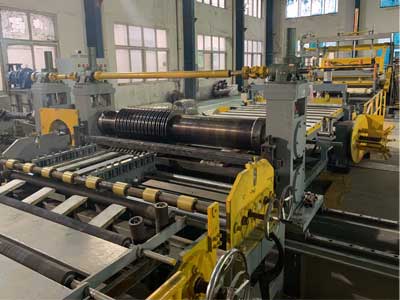intuduction
Slitting is a precision metal processing technique that involves cutting wide coils of steel or other materials into narrower strips. This process is performed using a specialized machine called a slitting line, which uses rotary knives to produce clean, consistent cuts with minimal material waste. Slitting is an essential step in preparing metal strips for further forming, stamping, welding, and manufacturing applications across a wide range of industries.
How the Slitting Process Works
The slitting process begins with feeding a master coil onto an uncoiler unit, after which the material is directed through a set of slitting knives. These circular blades are carefully positioned according to the required strip widths. Once the material passes through the cutting section, the newly formed strips are rewound into narrower coils known as slit coils. This process ensures smooth edges, high dimensional accuracy, and uniform strip quality.
Types of Materials Suitable for Slitting
Slitting is compatible with a diverse range of materials, including carbon steel, stainless steel, galvanized steel, aluminum, copper, and various coated or pre painted metals. The selection of proper knife materials, cutting clearances, and slitting speed depends on the hardness, thickness, and surface finish of the material being processed. Professional slitting ensures that the physical properties and surface integrity of the material remain fully preserved.
Applications of Slit Coils in Industry
Slit coils play a vital role in multiple industries, including automotive manufacturing, construction, HVAC, electrical systems, tube mills, appliance production, and furniture manufacturing. The precision and consistency of slit material allow for reliable downstream forming, welding, and assembly processes. Because of its versatility, slitting is considered one of the most valuable coil preparation operations in modern industrial production.
Key Components of a Slitting Line
A standard slitting line is composed of several main components, including an uncoiler, leveling unit, slitting head with rotary knives, tension stand, scrap system, and recoiler. Each element plays a distinct role in ensuring smooth material handling and accurate cutting. Modern slitting lines often include automation and computer control systems to increase efficiency, improve safety, and reduce operator workload.
Advantages of Using a Professional Slitting Service
Professional slitting services provide high levels of precision and repeatability, enabling manufacturers to obtain material in exact widths tailored to their production needs. Additional benefits include reduced material waste, lower production costs, improved throughput, and optimized manufacturing flow. Reliable slitting providers also maintain consistent quality control to ensure the performance of each coil meets strict industry specifications.
Why LOTOSSLITTING is a Trusted Slitting Manufacturer
LOTOSSLITTING is recognized for its advanced slitting line technology, engineering excellence, and commitment to customer satisfaction. The company offers full service slitting solutions, including machine design, manufacturing, installation, operator training, and after-sales support. With a focus on precision, durability, and efficiency, LOTOSSLITTING equipment is widely used by coil processing centers, tube mill manufacturers, and industrial production plants worldwide.
Slitting is the process of cutting a wide coil of metal into narrower strips using a slitting line equipped with rotary knives. It ensures precise widths, smooth edges, and consistent quality, making it suitable for downstream manufacturing processes.
Slitting can be performed on a variety of metals including carbon steel, stainless steel, galvanized steel, aluminum, copper, and coated or pre-painted metals. The choice of cutting parameters depends on material thickness, hardness, and surface finish.
The process starts by feeding a metal coil onto an uncoiler. The coil then passes through a set of rotary knives positioned according to the desired strip widths. Finally, the cut strips are rewound into slit coils ready for further processing.
Slit coils are widely used in automotive manufacturing, construction, HVAC systems, tube mills, appliances, and furniture production. Their precise widths and clean edges make them ideal for forming, stamping, welding, and assembly.
A typical slitting line includes an uncoiler, leveling unit, slitting head with rotary knives, tension stand, scrap system, and recoiler. Modern slitting lines may also feature automation for improved precision, efficiency, and safety.

